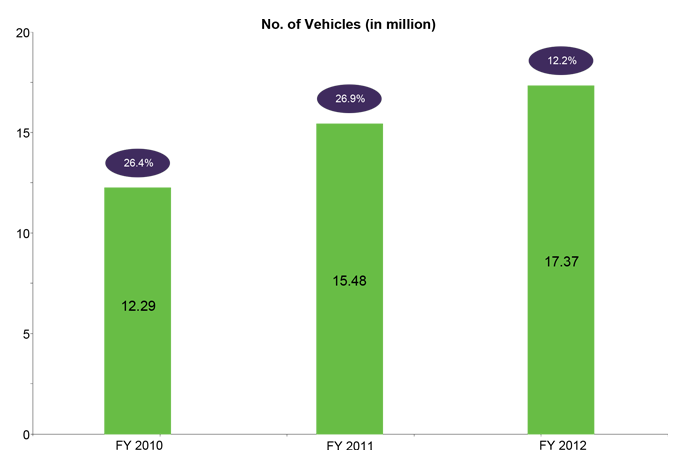The Indian automotive industry comprises of a number of Indian-origin and multinational players with varying degree of presence in different segments. Today, nine of the top ten global automotive manufacturers have a presence in India which clearly points to its importance as a strategic market.
Similarly, the domestic tractor market also has a mix of Indian–origin and international manufacturers and is segmented by horsepower into sub 30 HP segment, the 30-40 HP segment, the 40-50 HP segment and the higher segment of above 50 HP.
In spite of the challenging macroeconomic environment – both domestic and global, the Indian automotive industry (excluding two wheelers) crossed the 3.9 million mark and registered a growth of 6.2% during the Financial Year 2011-12. The passenger vehicle segment grew by 4.7% with domestic sales crossing 2.6 million vehicles. Within this segment, the multi-purpose vehicle (MPV) segment grew by 10.0% and the utility vehicle (UV) segment registered a growth of 16.5%
The Commercial Vehicle (CV) segment grew by 18.2%. This growth principally driven by an increase of 27.4% in the Light Commercial Vehicle (LCV) segment the Medium and Heavy Commercial Vehicles (MHCV) segment grew by 7.9%. Within the LCV segment the growth was greatest in the less than 2 tonne segment (growth of 31.3%) and the 2-3.5 tonne segment (growth of 34.8%)
The three wheeler segment grew by 2.4% during the year. The three wheeler goods segment grew by 6.3% while the three wheeler passenger segment witnessed a growth of 4.5%
During the Financial Year 2011-12 the two-wheeler segment grew by 14.2%. Within the two-wheeler segment, scooters/scooterettes grew by 24.5%, motorcycles/step-through by 12.01% and mopeds by 11.4%.
The growth across several segments of the Indian Automotive Industry was significantly lower than that projected by SIAM (Society of Indian Automobile Manufacturers) at the beginning of the year. This was due to factors such as uncertainty over economic growth, high vehicle financing rates, high inflation leading to less discretionary expenses, rise in commodity prices leading to increase in vehicle prices and hike in fuel cost.
The adverse impact on industry growth was also because of short supply of vehicles due to prolonged labour unrest at a major automotive manufacturer and disruption of components supply from Thailand which suffered the onslaught of floods.
The table below summarises the growth of the various segments of the Indian Automotive industry as compared to the previous year
Source: Siam India

